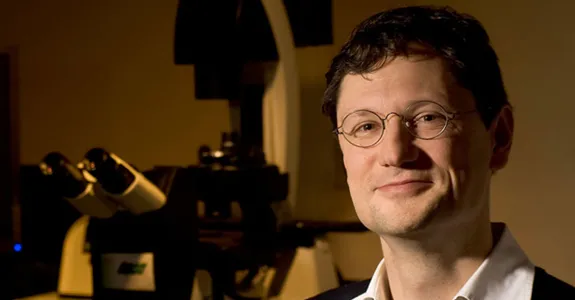
Thomas Christian Südhof was born in Göttingen, Germany, on Dec. 22 in 1955, obtained his M.D. and doctoral degrees from the University of Göttingen in 1982. He performed his doctoral thesis work at the Max-Planck-Institut für biophysikalische Chemie in Göttingen with Prof. Victor P. Whittaker on the biophysical structure of secretory granules. From 1983-1986, Südhof trained as a postdoctoral fellow with Drs. Mike Brown and Joe Goldstein at UT Southwestern in Dallas, TX, and elucidated the structure, expression and cholesterol-dependent regulation of the LDL receptor gene. Südhof began his independent career as an assistant professor at UT Southwestern in 1986. When Südhof started his laboratory, he decided to switch from cholesterol metabolism to neuroscience, and to pursue a molecular characterization of synaptic transmission. His work initially focused on the mechanism of neurotransmitter release which is the first step in synaptic transmission, and whose molecular basis was completely unknown in 1986. Later on, Südhof's work increasingly turned to the analysis of synapse formation and specification, processes that mediate the initial assembly of synapses, regulate their maintenance and elimination, and determine their properties. Südhof served on the faculty of UT Southwestern in Dallas until 2008, and among others was the founding chair of the Department of Neuroscience at that institution. In 2008, Südhof moved to Stanford, and became the Avram Goldstein Professor in the School of Medicine at Stanford University. In addition, Südhof has been an Investigator of the Howard Hughes Medical Institute since 1986.
For a person to think, act, or feel, the neurons in a person’s brain must communicate continuously, rapidly, and repeatedly. This communication occurs at synapses, specialized junctions between neurons that transfer and compute information on a millisecond timescale. By forming synapses with each other, neurons are organized into vast overlapping neural circuits.
As intercellular junctions, synapses are asymmetric with a presynaptic terminal that emits a transmitter signal and a postsynaptic cell that receives this signal. Synapses differ in properties and exhibit distinct types of plasticity, enabling fast information processing as well as learning and memory. Synapses are the most vulnerable component of the brain whose dysfunction initiates multifarious brain disorders. Despite their importance, however, synapses are poorly understood beyond basic principles.
Dr. Südhof’s laboratory studies how synapses form in the brain and how their properties are specified, which together organize neural circuits. Moreover, the Südhof laboratory examines how synapses become dysfunctional in neurodegenerative and neuropsychiatric disorders to pave the way for better therapies.










